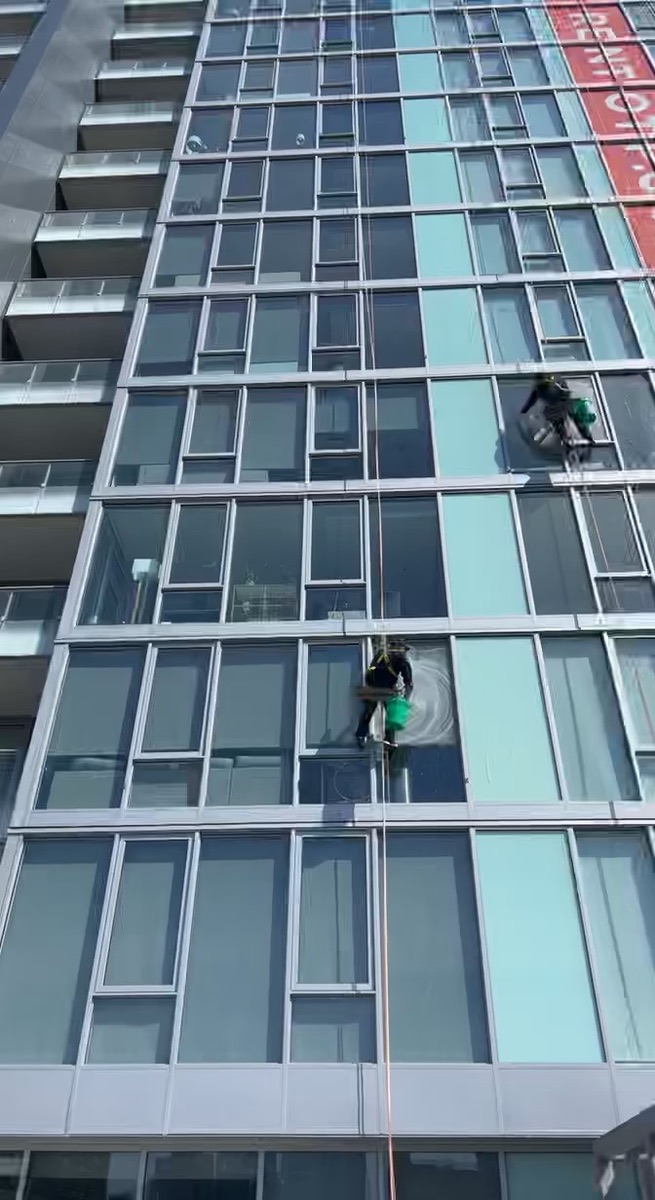Have you ever wondered how dangerous high-rise window cleaning can be? Imagine dangling hundreds of feet in the air, tasked with maintaining the sparkling appearance of skyscrapers. It’s a risky business, but is it as difficult as it seems?
This comprehensive blog post will uncover the risks and hazards that high-rise window cleaners face daily. From potential falls to equipment failures and weather-related challenges, we will provide an in-depth analysis of the dangers associated with this thrilling profession.
But don’t worry; we’ll also review the safety precautions, and best practices experts use to reduce dangers. Learn from real-world examples and case studies of how safety precautions have saved lives and averted accidents. Learn how the industry always works to enhance safety standards and safeguard its people.
So come with us on an eye-opening tour into the world of high-rise window washing safety. Continue reading to learn more about the hazards, how experts manage them, and what advancements are in store for the future of this adventurous industry.
Risks and Hazards in High-Rise Window Cleaning
Contents
- 1 Risks and Hazards in High-Rise Window Cleaning
- 2 Safety Measures and Best Practices
- 3 Frequently Asked Questions
- 3.1 Are there any regulations in place to ensure the safety of high-rise window cleaners?
- 3.2 How often should equipment be inspected and maintained to ensure safety?
- 3.3 How do high winds affect the safety of high-rise window cleaning?
- 3.4 What qualifications and certifications should high-rise window cleaners possess?
- 3.5 How do high-rise window cleaners mitigate the risk of glass breakage and falling debris?
Fall hazards:
One of the most significant risks in high-rise window cleaning is the potential for falls. Workers are often suspended at dizzying heights, making even a tiny slip potentially fatal.
According to the Occupational Safety and Health Administration (OSHA), falls are the leading cause of fatalities in the construction industry, which includes high-rise window cleaning.
Equipment failures:
High-rise window cleaners rely heavily on equipment such as harnesses, ropes, and anchors. Any failure in these components can lead to disastrous consequences.
Regular inspection and maintenance are crucial to ensure the reliability and safety of the equipment.
Adverse weather conditions like high winds, rain, or extreme temperatures can make high-rise window cleaning even more dangerous.
Wind, in particular, can cause workers to lose control, making it difficult to maintain balance or operate equipment safely.
Glass breakage and falling debris:
High-rise window cleaners risk falling not just from themselves but also from falling things such as broken glass or debris.
Accidents due to such situations must be avoided since they endanger employees and civilians on the ground below.
Fatigue and human error:
The physically demanding nature of high-rise window washing can cause exhaustion, which increases the risk of errors.
To reduce the risk of accidents caused by fatigue or human mistakes, proper training, attention to safety rules, and regular breaks are required.
Understanding the risks and hazards involved with high-rise window cleaning allows experts to work toward establishing appropriate safety measures and best practices to reduce the risks associated with this challenging industry.
Safety Measures and Best Practices
Proper training and certification:
Ensuring high-rise window cleaners receive adequate training and certification is crucial for maintaining safety. This includes understanding industry standards, such as the International Window Cleaning Association (IWCA) Safety Certification, and adhering to OSHA regulations.
Use of appropriate Personal Protective Equipment (PPE):
High-rise window cleaners should always wear proper PPE, including helmets, gloves, safety harnesses, and fall arrest systems. These items help protect workers from potential hazards and minimize the risk of injury in case of an accident.
Regular equipment inspection and maintenance:
To reduce the danger of equipment failure, conducting frequent inspections and executing necessary maintenance on all high-rise window cleaning equipment is critical.
Check for evidence of wear or damage on ropes, harnesses, anchors, and other safety gear.
Frequently Asked Questions
Are there any regulations in place to ensure the safety of high-rise window cleaners?
Yes, there are regulations set by organizations such as OSHA and the International Window Cleaning Association (IWCA) to ensure the safety of high-rise window cleaners. These regulations cover aspects such as training, equipment requirements, and safety standards.
How often should equipment be inspected and maintained to ensure safety?
Equipment used in high-rise window cleaning should be inspected regularly, ideally before each use, and undergo necessary maintenance. This includes checking ropes, harnesses, anchors, and other safety gear for any signs of wear or damage.
How do high winds affect the safety of high-rise window cleaning?
High winds can greatly impact the safety of high-rise window cleaning. Strong gusts can make it difficult to maintain balance and control while working at heights. It is important for window cleaners to monitor weather conditions and suspend operations during high wind events.
What qualifications and certifications should high-rise window cleaners possess?
High-rise window cleaners should undergo proper training and attain certifications to ensure their competence and safety. Certification programs such as the IWCA Safety Certification provide the necessary knowledge and skills to perform the job safely.
How do high-rise window cleaners mitigate the risk of glass breakage and falling debris?
High-rise window cleaners take precautions to mitigate the risk of glass breakage and falling debris. This may include using safety nets, installing protective barriers, or establishing protocols to handle broken glass and debris. Regular inspection of the building’s facade can also help identify potential risks in advance.


